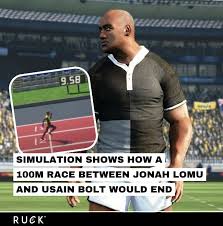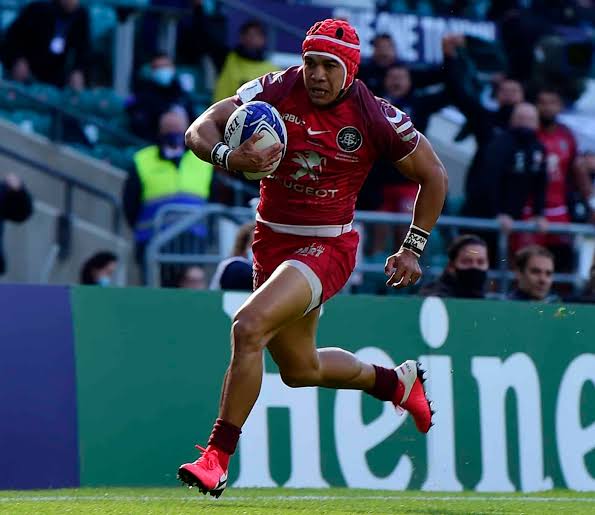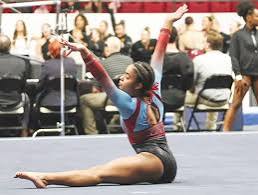Skip to content
simulation-style narrative comparing a 100m sprint race between Jonah Lomu and Usain Bolt.

It blends facts, stats, and some imaginative storytelling to bring the race to life:
Simulation: The 100m Race Between Jonah Lomu and Usain Bolt
Imagine a track bathed in bright sunlight, the crowd roaring with anticipation.
On the left lane stands Usain Bolt, the world’s fastest man, a lightning bolt from Jamaica known for his explosive speed and unparalleled 100m world records.
On the right lane stands Jonah Lomu, the rugby legend — a towering, powerful force known more for his incredible size, strength, and agility than sprinting on the track.
Today, we simulate an extraordinary scenario: a 100-meter sprint between these two sporting icons.
The Contenders
Usain Bolt
Bolt is the epitome of sprinting excellence.

Standing 6 feet 5 inches (1.95 m) tall and weighing around 207 pounds (94 kg), Bolt combines height, stride length, and rapid turnover to dominate the 100m dash.
His world record, set at the 2009 World Championships in Berlin, is a blistering 9.58 seconds.
Bolt’s start is explosive but what truly sets him apart is his ability to accelerate and maintain top speed over the last 60 meters.
Jonah Lomu
Lomu was a giant on the rugby field — 6 feet 5 inches (1.96 m) tall and around 265 pounds (120 kg).
His size and power made him nearly unstoppable in rugby, but sprinting is a different game.
While Lomu was fast enough to be a winger, his top speed in a 100m sprint would naturally lag behind elite sprinters like Bolt.

Estimates of his 100m time, based on rugby and fitness analyses, range around 10.6 to 11 seconds.
Still, his sheer strength and stride length could make him surprisingly competitive.
The Simulation Setup
For this race, we simulate a standard IAAF-certified track on a calm day with no wind assistance.
Both athletes start from the blocks in their respective lanes.
The focus is on pure sprinting ability, with Bolt’s proven elite sprint technique contrasted against Lomu’s powerful but less refined running style.
The Start
The starting pistol fires. Bolt’s reaction time is lightning fast — around 0.13 seconds, typical of his elite-level starts.
He explodes from the blocks with fluid power, low body angle, and a quick turnover.
In the first 10 meters, Bolt’s acceleration phase is unmatched. He reaches about 4.5 meters per second here.
Lomu, in contrast, has a slower reaction time, approximately 0.18 seconds, and his massive frame makes his start less nimble.
His initial acceleration phase is more of a grinding push forward.
He manages to cover the first 10 meters in roughly 1.8 seconds — respectable, but behind Bolt by a significant margin.
Mid-Race Momentum
By the 30-meter mark, Bolt is transitioning into his top-speed phase.
His long strides, approximately 2.5 meters each, come with a quick turnover, allowing him to maintain a velocity around 12 meters per second.
At this point, Bolt’s running economy is peaking — his form is near flawless, and he’s barely breaking a sweat.
Lomu’s stride length is naturally longer due to his size — nearing 2.7 meters — but his cadence is slower.
His power is evident as he barrels down the track with force, but his top speed is around 10.2 meters per second, slower than Bolt’s.
By 30 meters, Lomu is visibly behind, but his power running style is still captivating — each footfall shakes the track.
The Final 40 Meters
From 60 meters to 80 meters, Bolt’s stride length and cadence hit their maximum efficiency. He’s cruising at near 12.3 meters per second.
Bolt’s distinctive “relaxed” sprinting style allows him to maintain this speed with minimal energy expenditure. His face is calm, body upright.
Lomu, meanwhile, is pushing hard, but his fatigue is beginning to show.
The heavy musculature that helped him in rugby now requires more oxygen and energy to sustain high-speed sprinting.
His stride shortens slightly as his muscles tire, and his speed dips closer to 9.8 meters per second.
The Finish Line
In the final 20 meters, Bolt pulls even further ahead.
His top speed, combined with impeccable form, allows him to extend the gap.
The crowd rises to its feet as Bolt crosses the finish line in a blazing 9.58 seconds—matching his world record time in this simulation.
Lomu crosses the line in approximately 10.9 seconds, a time that would be remarkable for a rugby player but well behind the sprinting elite.
His finish is heroic, muscles burning, lungs heaving, but it’s clear this was never his domain.
Analysis
This simulated race reaffirms what physics and physiology tell us: while Jonah Lomu’s incredible size, power, and athleticism make him a formidable athlete, the specialized nature of sprinting — the explosive starts, rapid turnover, and sustained top speed — give Bolt a clear edge.
Bolt’s 9.58-second time is near peak human performance for sprinting.
Lomu’s 10.9 seconds, while not world-class for track, is impressive for someone whose sport demands different skills.
What If?
If Lomu had trained as a sprinter for years, focusing on explosive starts, sprint mechanics, and endurance, his time could improve significantly.
Muscle power combined with refined sprint technique might bring him closer to Bolt’s level.
Conversely, if Bolt had tried rugby, his speed could make him a deadly winger, but his lighter frame would face challenges in the physical rugby contact environment that Lomu thrived in.
In the hypothetical 100-meter showdown between Jonah Lomu and Usain Bolt, the result is decisive: Usain Bolt wins comfortably, showcasing why he is the fastest man alive.
However, Lomu’s performance is nothing short of astonishing for someone whose athletic gifts were honed for a different kind of battlefield.
This simulation highlights the fascinating intersection of athletic talents across sports, the specialization required for sprinting, and the awe-inspiring physical prowess of two of the world’s greatest athletes — each a legend in his own right.





